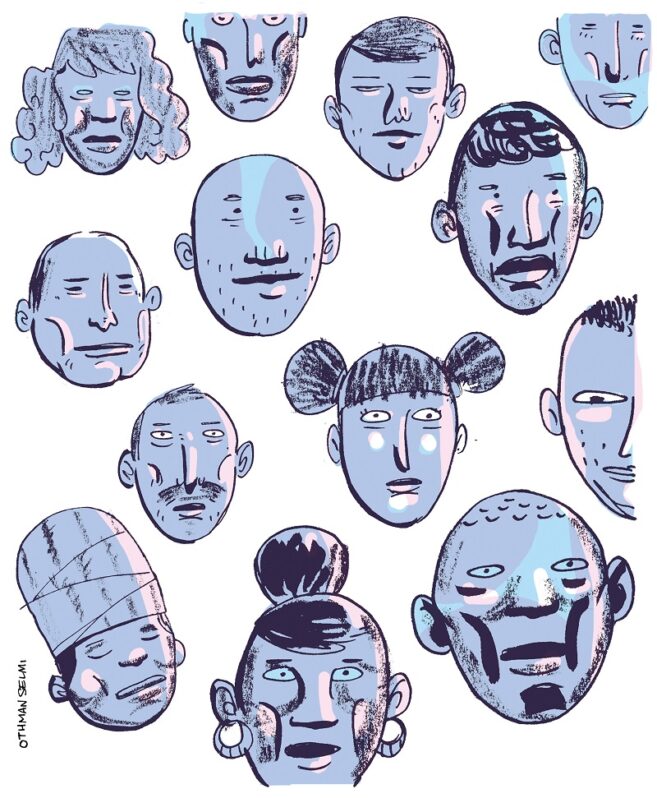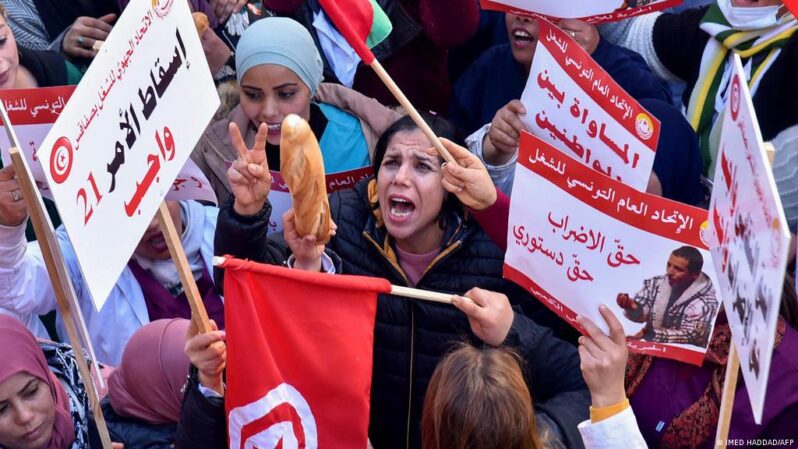Tunisia’s National Consultation: A Deception That Fooled Only the Deceiver

On the night of April 1, 2022, President Kais Saied closed the curtain on the final act of the “national consultation” charade by announcing its results. The consultation [an online questionnaire] lasted 65 days, during which the various state apparatuses mobilized to render it a success. Yet when it ended on March 20, no more than 535,000 people – 6% of the electorate – had responded. This figure was enough for the president to declare it a success, accuse its opponents of conspiring to prevent the people from expressing its will, and draw on its “results” to rewrite the rules of the democratic game however he wishes (there can be no “dialogue” not “based on the consultation’s outcomes”). As expected, the responses were in line with intentions of the questions’ drafters, i.e. as a supposed legitimization of the president’s plan for “bottom-up construction”.
Bottom-Up Construction Through and Through
The president presented the consultation’s results in a meeting with the minister of communication technologies and the prime minister one month after dissolving Parliament and initiating the prosecution of the MPs who participated in a virtual general assembly before the Anti-Terrorism Unit. From the first ten minutes, it was evident that Saied sought to respond to demands by some political forces for early elections within the constitutional timeframes (between 45 and 90 days after Parliament’s dissolution). He stated that he is proceeding with his plan and roadmap, which involves altering the political and electoral system via a referendum on July 25 and holding back legislative elections (should they occur) until December 17.
The choice of December 17 for legislative elections reflects not only the president’s obsession with symbolic dates but also his perspective on the revolution. He reduces the revolution to the moment it broke out in the interior regions on December 17. January 14, on the other hand, symbolizes the “theft” and “perversion” of the revolution by the elites in the center. This is the same perspective ostensibly underpinning the “bottom-up construction” plan championed by Saied and his supporters, which formed during the years following the revolution as an antithesis to the choices of the democratic transition.
Ostensibly, bottom-up construction is based on elections in which voters vote for individual candidates in the smallest possible electoral districts, namely the sectors [‘imadat]. The elected candidates form local councils in each delegate [mu’atamadiyya, the territorial division above the sectors]. From each local council, a randomly chosen representative ascends to the national parliament. Hence, there is no need for national programs or intermediates. Rather, proposals ascend spontaneously from the local level to be “compiled” nationally. The elected representatives are also subject to a recall mechanism that allows voters to remove them during the parliamentary term (a mechanism whose conditions and procedures remain unexplained). As for executive authority, it lies in the hands of the president, who is elected directly. This upsets the balance between authorities as it results in a weak parliament composed largely of local barons under the constant threat of recall while all power is centralized in Carthage Palace.
As expected, the national consultation’s results lead directly to the three pillars of bottom-up construction, namely voting for individuals (71%), a presidential system (86%), and the power to recall MPs (92%). The phrasing of the questions could only have produced these responses.
For example, the question about the voting system included only two options, namely voting for individuals and “the list-voting system”, thereby implying that the only alternative to the current voting system is voting for individuals. Commenting on this question’s results, Saied said that Tunisians are capable of distinguishing between proportional voting with the largest remainder method and proportional voting with the highest averages method, and debating the pros and cons of each one (even though this is a technical matter). Yet he saw no point in including these systems as options in the consultation’s question. The objective was not to poll or involve Tunisians but to obtain a fatwa endorsing a preconceived project.
The same goes for recall. The president saw no obligation to ask Tunisians whether they want the power to recall all elected figures. Nor did he feel obliged to ask them directly whether they would like the ability to recall the president. The question was limited to recalling MPs and permitted only a yes/no response.
As for the preference for a presidential system, it is a natural consequence of the wave of hostility to parliamentarianism. This system will be excessively presidential because it lacks the conditions of political balance found, for example, in the strong and stable two-party system of the US.
Irrespective of the other details, the three pillars of the bottom-up system – a presidential system, voting for individuals, and the power to withdraw mandates – are enough to produce its worst outcome, namely an imbalance between authorities and excessive centralism disguised as “bottom-up-ism” [al-qa’idiyya].
To round out the “fatwa”, respondents were asked about the reforms most needed to improve political life. They could select up to three options from a list. Amending the electoral law came in first (61%), followed by amending the law regulating parties (44%), amending the Constitution (38%), and developing a new constitution (36%). In last place came amending the law regulating associations (26%). The intent behind the inclusion of two options concerning the Constitution was to push respondents to select one of them, i.e. to assume that the problem lies in the Constitution and wonder whether the solution is to amend or replace it. When reciting the two percentages, the minister of communication technologies combined them to give the impression that Tunisians want constitutional reform and obscure the fact that those calling for a new constitution (even among the consultation’s respondents, who do not necessarily encapsulate the will of the people) are a minority.
The questions in the consultation’s political and electoral section were not the only ones paving the way for bottom-up construction. Rather, such questions also appeared in the economic section. This section’s first question was oriented toward a “local” conception of socioeconomic problems. Thus, 75% of respondents agreed that the solution to socioeconomic problems “could be local”. The president used this response to justify the communitarian companies project, the decree for which he had issued on March 20. If the question asked had been about the jurisdictional level within which solutions to socioeconomic problems are most effective – and presented the national, regional, and local levels as options – would the response have been the same? Moreover, because a certain response was assumed when the question was drafted, most of the other questions in the economic section, and even in the other sections, had a local or regional dimension. Here too, the president only wanted to dress his preconceived plan in popular, democratic clothing. But the people disappointed him.
The People Do Not Share the President’s Desires
Since announcing the roadmap last December, Saied has seized every chance to promote the consultation and market it as an unprecedented opportunity for the people to express their will. All efforts were exerted to render it a success. State apparatuses – including the ministries (particularly the Ministry of Youth and Sports and the Ministry of Communication Technologies), the governorates and delegations, and public media – were mobilized. The question of the resources allocated for the consultation remained unanswered as it did not appear in these public bodies’ budgets for 2022.
From the very first days following the consultation’s launch, the population appeared reluctant to participate. Yet as usual, the president hid behind conspiracy theories. Rather than revising his choice, he put intense pressure on state apparatuses to redouble their efforts to encourage participation, even changing the requirements. The age requirement was lowered from 18 to 16 based on a belief that this cohort is among those most connected to the internet. However, the final figures showed that just 6,400 students responded. Ironically, this move coincided with the leak of a bill to amend the Associations Decree that raises the age requirement for establishing associations from 16 to 18. In other words, the encouragement of youth participation came not out of a conviction that youth should be involved in public affairs but out of a desire to use them to support presidential projects.
The condition that the respondent’s mobile number be registered in their name, intended to prevent fraud, was also abandoned in early February. Thus, respondents could use any mobile number if they only provided a national ID number and date of birth, which are widely accessible because of the lack of respect for personal data in Tunisia. Many universities publish this data publicly on social media when they announce students’ results. In other words, nothing guarantees that the consultation’s turnout, which is already low, is accurate and people were not impersonated. There were no means for people to check whether their national ID numbers had been used even though such means existed in the 2014 and 2019 presidential elections with regard to candidates’ endorsements.
Meanwhile, most Tunisians received messages on their phones – sometimes weekly – encouraging them to participate. Public media ran constant advertisements. Tunisia TV dedicated a special program to the consultation featuring members of the president’s electoral campaign (the so-called “explanatory campaign”) masquerading as experts or impartial youth. The exploitation of public media even involved the dedication of an episode of a religious program to “youth participation in public life”. The program used religious arguments to encourage viewers to participate in the consultation. Consequently, the Independent High Authority for Audiovisual Communication warned Tunisia TV not to “exploit religion for political purposes” again.
Despite all these efforts and Saied’s repeated use of the presidential platform to promote the consultation, the final turnout was just 535,000. Irrespective of the doubts over this figure’s credibility, it constitutes only 18% of the turnout in the last legislative elections (2019), 12% of the turnout in the constituent elections in 2011, and 6% of the electorate. It is less than the number of Saied voters in the first round of presidential elections in 2019. While this turnout does not necessarily mean that Saied is unpopular, it at least shows that bottom-up construction stems not from the will of the people but from the will of the president and his campaign. Despite the attempt to lure respondents with sections on socioeconomic affairs, sustainable development, quality of life, and education and culture, it was clear to everyone that the crux of the consultation was the first section, which addressed politics and elections. The poor turnout is evidence that the “people” want not a reconstitution but prompt solutions to the socioeconomic crisis. While a key weakness of the democratic transition was its inability to address people’s day-to-day challenges and its domination by constitutional and legal debate, Saied and his bottom-up construction epitomize this inability. The difference is that the socioeconomic situation can no longer wait. Saied, oblivious to the gravity of the situation and his inability to address it, is marching forward with his personal fantasy of writing a new chapter of history, trampling over the revolution’s accomplishments one after another in the revolution’s name.
This article is an edited translation from Arabic.
لقراءة المقال باللغة العربية اضغطوا هنا



